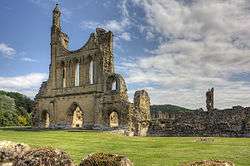Byland Abbey
|
| |
| Monastery information | |
|---|---|
| Order | Savigniac, Cistercian 1148 |
| Established | 1155 |
| Disestablished | 1538 |
| Diocese | Diocese of York |
| People | |
| Important associated figures | Abbot Roger, Roger de Mowbray |
| Site | |
| Location | Byland, Coxwold, North Yorkshire, England |
| Visible remains | substantial |
| Public access | yes |
Byland Abbey is a ruined abbey and a small village in the Ryedale district of North Yorkshire, England, in the North York Moors National Park.
History
It was founded as a Savigniac abbey in January 1135 and was absorbed by the Cistercian order in 1147. It wasn't an easy start for the community who had had to move five times before settling at New Byland, near Coxwold in 1177. Its early history was marked by disputes with no fewer than four other religious establishments: (Furness Abbey, Calder Abbey, Rievaulx Abbey and Newburgh Priory). However, once it had overcome this bad start, it was described in the late 14th century as "one of the three shining lights of the north". Its financial success was not as great as that of places like Rievaulx, but it was famed for its sheep rearing and wool exports. Its church was said to be among the finest 12th-century churches in Europe.
It was dissolved on 30 November 1538. In 1539, its site was granted to Sir William Pickering.
Description
Impressive remains can still be seen, in the care of English Heritage, including the lower half of a huge rose window. An interesting feature is the preservation of some of the brightly coloured medieval floor tiles. An altar table was also recovered, although that is now in Ampleforth, and a stone lectern base from the chapter house is the only example of its kind in Britain.[1]
- Selected images
_(14776819444).jpg) Byland Abbey as depicted in The ruined abbeys of Yorkshire (1883)
Byland Abbey as depicted in The ruined abbeys of Yorkshire (1883)May2005.jpg) Byland Abbey, May 2005
Byland Abbey, May 2005 Byland Abbey in August 2013
Byland Abbey in August 2013
See also
- Battle of Old Byland
- Wimund (bishop) - English bishop, later turned pirate, was held here after his capture in the 12th century.
References
External links
![]() Media related to Byland Abbey at Wikimedia Commons
Media related to Byland Abbey at Wikimedia Commons
- Byland Abbey website history, building and lands.
- Official page: English Heritage
Coordinates: 54°12′11″N 1°09′33″W / 54.2031°N 1.1592°W
